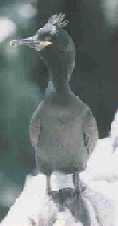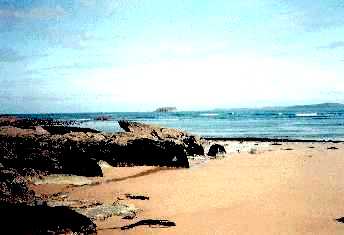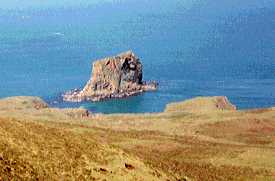The Sea Coast of Inishowen is long and varied. The Atlantic Coastline around Malin Head in the north has a different community of wildlife to the more sheltered coastline in Lough Foyle and Lough Swilly.
Malin Head is the most northerly point of the Irish mainland but to the North East lies the small island of Inishtrahull. This island has the oldest rocks in Ireland and is closer in rock type to Greenland. A small community of fishermen and there families lived here until the early 1900's and a manned Lighthouse only became automatic a few years ago. Now the island is left to the birds and the Grey Seals that breed on nearby rocky islets.
Eider Duck nest among the gravestones on Inishtrahull and are common around the rocky coast of Malin Head. In the Summer you will see the large white seabird with black wing tips, the Gannet making spectacular dives for fish from a height of 30mts or so. These birds come to feed from their nearest nesting colonies in the western isles of Scotland and will later regurgitate the fish to feed their young. Malin Head is a good point to look out for migrating seabirds in Autumn and Spring. Manx Shearwaters pass in large numbers in Autumn to pass the winter off the coasts of South America.
Birds that nest on the cliffs of North Inishowen include the Shag, Guillemot, Fulmar and Kittiwake. The Fulmar looks like a seagull but is related to Albatross which can be seen in it's stiff winged flight. Fulmars were rare in Ireland but is thought to have benefited from the waste products of the fishing industry. An easy place to see Fulmars is nesting on cliffs beside the car park at Dunree Fort Military Museum (where there is also a small museum showing the wildlife of the peninsula). Rock Doves which are the wild ancestors of city pigeons nest on ledges of sea caves. The Chough is a rare bird of the crow family similar to a Jackdaw but with slender red bill and red legs.

The Shag, above, is a bird of the Atlantic coast and nests low down on cliffs around Malin Head and on Inishtrahull. The Cormorant, which is very similar at a distance, is a bird of more inland waters and can be seen on the river Foyle in the centre of Derry.
Two birds that are not normally associated with the sea avail of sea cliffs as nesting sites in spring. Ravens and Peregrine Falcons build there nests on the remoter cliffs of Inishowen.
Seagulls are the most familiar seabirds all around the coastline. The species that are common are - Black Headed Gull, Common Gull (though not the most common), Herring Gull, Greater Black Backed Gull and Kittiwake. In the summer Sandwich Terns and Common Terns dive for sand eels along the sandy beaches. Terns are like elegant seagulls with swallow like wings and tails.
Another bird seen all around the coastline is the Oystercatcher (see above beside the page title). These black and white birds with long red bills and legs have a distinctive "peep peep" call. A similar looking but much smaller winter visitor is the Turnstone which gets it's name from it's habit of turning over small stones in it's search for small shellfish. Another small black and white bird is the Ringed Plover which is almost invisible among the beach shingle and pebbles until it does it's distinctive quick burst of running and then you move closer and ten fly up in a flock.


There are plenty of other creatures of interest on the coast in addition to birds. The twice daily withdrawal of the sea reveals a large community of animals, especially on rocky coast, that live in their particular niche. The most apparent at low tide covering nearly every rock surface are Barnacles. These are not molluscs like other shellfish but crustaeceans related to shrimps and crabs. If you look closely at the top of the shell is a "trapdoor" which opens when the tide comes in and it's feathery legs extend out to trap drifting plankton. The larger conical shaped shellfish among the barnacles are Limpets which move around grazing minute plant life from the rocks but always return to the same spot when the tide goes out. The snail-like shellfish common on the rocky beach are Winkles of which their are various species at different zones of the beach. Whelks are similar to winkles but with a more pointed shell. These shellfish are carnivors. Among the small shells washed up on a beach you will find many with a small neat hole that has been drilled by a Whelk.
A short time spent looking in a rock pool will reveal a wealth of different creatures. The Hermit Crab does not have the hard body shell of other crabs and has to inhabit an empty whelk shell. As it grows larger it has to move house and find a bigger shell each time. Sea Anemones are like bright red plants attached to rocks but are actually animals related to jellyfish and capture small creatures with their stinging tentacles.
Many of the shells found on the beach such as Razor Shell, Cockle, Tellins and Sand Gapers spend there lives submerged in the sand with only their siphons protruding above to extract food particles from the water.
From time to time some unusual animals are washed up on the beaches of Inishowen. In the last few years two specimens of the rare sea turtle Kemp's Ridley have been found, at Ballyliffin and Dunree beaches. This turtle only breeds in a small area of the Gulf of Mexico and there are only a few thousand of them left. A few Leatherback Turtles have also turned up. The Leatherback is the largest Turtle in the world and can grow to about 2 metres long. A Sperm Whale is among the sea mammals periodically beached and in the 1970's a Killer Whale swam right up Lough Foyle to the centre of Derry City.
